Comets
Images of the visiting 'Devil’s-Horn' comet reveal complex inner structure of the coma
“Comets are like cats: they have tails and do what they want” – as was noted by a famous comet-hunter David Levy. This year’s much-ballyhooed green comet C/2022 E3 (ZTF) that promised great spectacle in January vanished without much display. However, the periodic comet 12P/Pons-Brooks has attracted the world’s attention this visit when this July it suddenly started behaving very unusually – producing outbursts – large releases of dust and gas, so strangely that it was called `devil-horned’ comet in the media because the emitted clouds of ice and gas looked like a gigantic pair of horns. Comet P12/Pons-Brooks was discovered in 1812 and orbits the Sun with a period of 71 years. During its earlier approaches to the Sun, astronomers had observed multiple ejections of gas and dust from its nucleus, which typically gave it an appearance of being horned. “This approach seems no different.
Other resources say it looks like the Millennium Falcon spaceship from Star Wars. We have observed it on the Himalyan Chandra Telescope (HCT), Hanle, Ladakh on 21 November in several different filters.

This comet is what is called a cryovolcanic comet. Unlike volcanoes on Earth, which eject hot magma from the planet's mantle, this comet spits out extremely cold gases and ice from its supercold interior. Cryovolcanic bodies, which include 10 to 20 known comets and several Solar System moons like Enceladus, Europa, and Triton, have a surface crust surrounding a mainly solid icy core, filled with a mix of ice, dust, and gas. As a comet comes closer to the Sun, solar radiation heats the comet, the pressure builds up beneath the crust, although some gas continually leaks out at the same time. Closer to the Sun, the cryomagma gets superheated, the pressure causes the outer shell to crack and cryomagma shoots out into space. After an eruption, the comet's coma -- a fuzzy cloud of cryomagma and dust -- expands and, since dust and ice are excellent reflectors of sunlight, the comet suddenly appears to get much brighter, even 100 times the original brightness, which happened already four times since July. After the latest November outburst, the comet developed more strange structures – like the strange dark lane in the comet's coma looking like a curved jet. There are several possibilities according to experts. One possible reason could be the shadow of its huge nucleus around the cloud of gas and dust from the outburst. As the dust sweeps past the body of the nucleus, it acts like air passing over the wing of an airplane, and that creates the hollowed-out shape and horns. Or, since it is curved and its curvature matches that of the top bright jet, that dark lane may be a shadow cast by the outflowing bright cryomagma jet projected onto the coma.
We created the `true’ colour image by combining images taken through 3 different colour filters (called red, blue, and green). Since the comet is moving rapidly across the sky, when we co-add the three images centred on the comet, we see stars from each of the exposures at different locations and of respective filter colours. The comet is still far from the Sun – beyond Mars orbit thus it has no usual comet tail yet, but its coma (atmosphere) is already about 350,000 km across (>7000 times more than the nucleus).

In mid-November, it was reported that the comet had suffered a possible core break-up, or that it could even be a binary comet. We do not see the second core in our images, but some bright patch is seen in this i-filter false-colour image, showing previous `second core’ dissipating into jets.
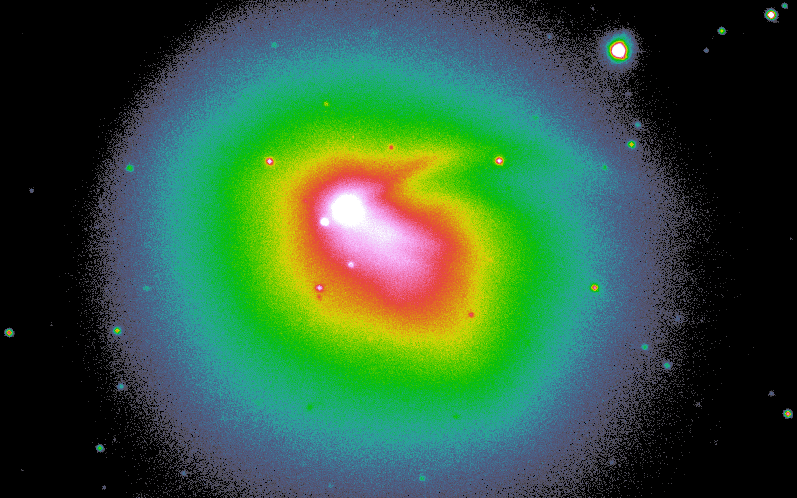
To better see the finer inner structure of the coma, we have created an intensity map by removing smooth emission using Larson-Sekanina digital filter. Four jets are clearly visible in g filter combined image (left), while in i filter combined image (right) there is a jet in the opposite direction. Credits: Margarita Safonova (IIA) and Marek Husárik (Slovakian Astronomical Institute).
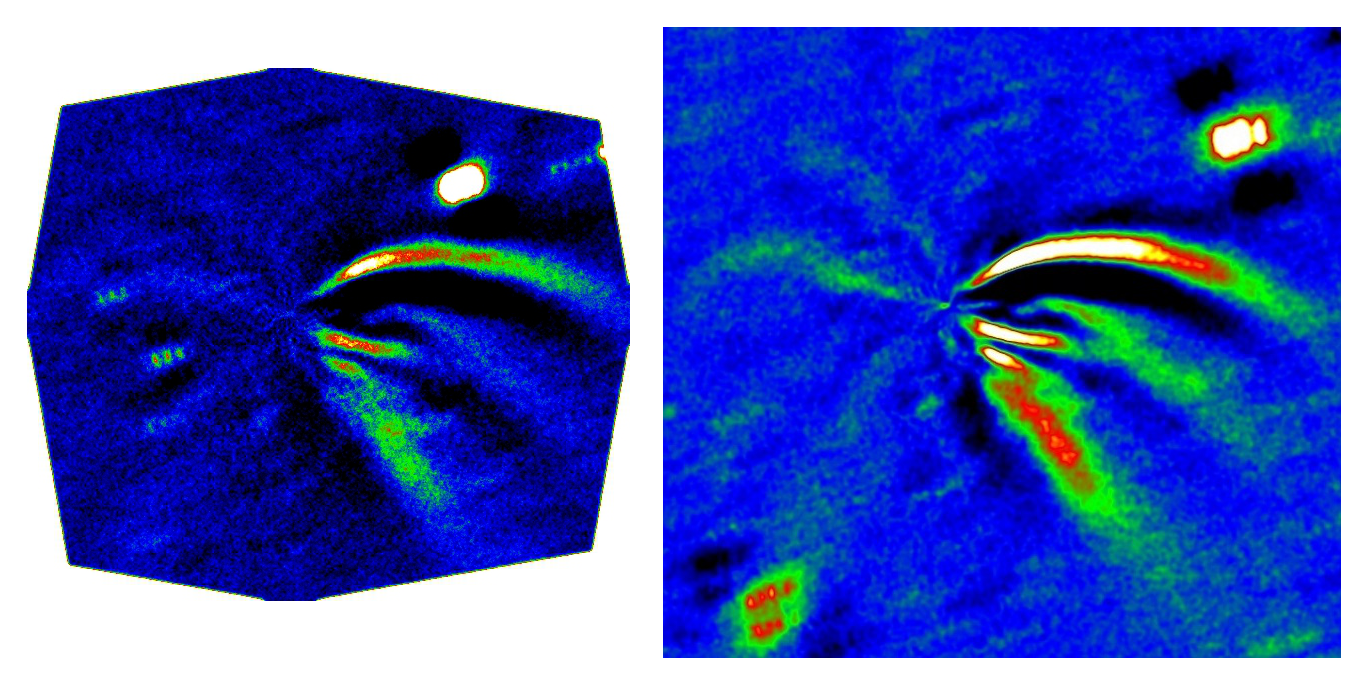
The comet was also observed with a spectrograph on the HCT on 22nd November (observers: Pramod Kumar, IIA, Koshvendra Singh, TIFR Mumbai, and Aravind K., PRL Ahmedabad). The comet spectrum is made up of fluorescence emissions from different molecular species, like Cyanogen (CN), Diatomic (C2) and triatomic (C3) carbon, and their various bands, e.g., CN (0-0) and CN (0-1), arising due to their transition between different energy levels. Each band represents a unique spectral signature, allowing us to decode the details of comet’s composition (credit: Aravind K., PRL Ahmedabad).
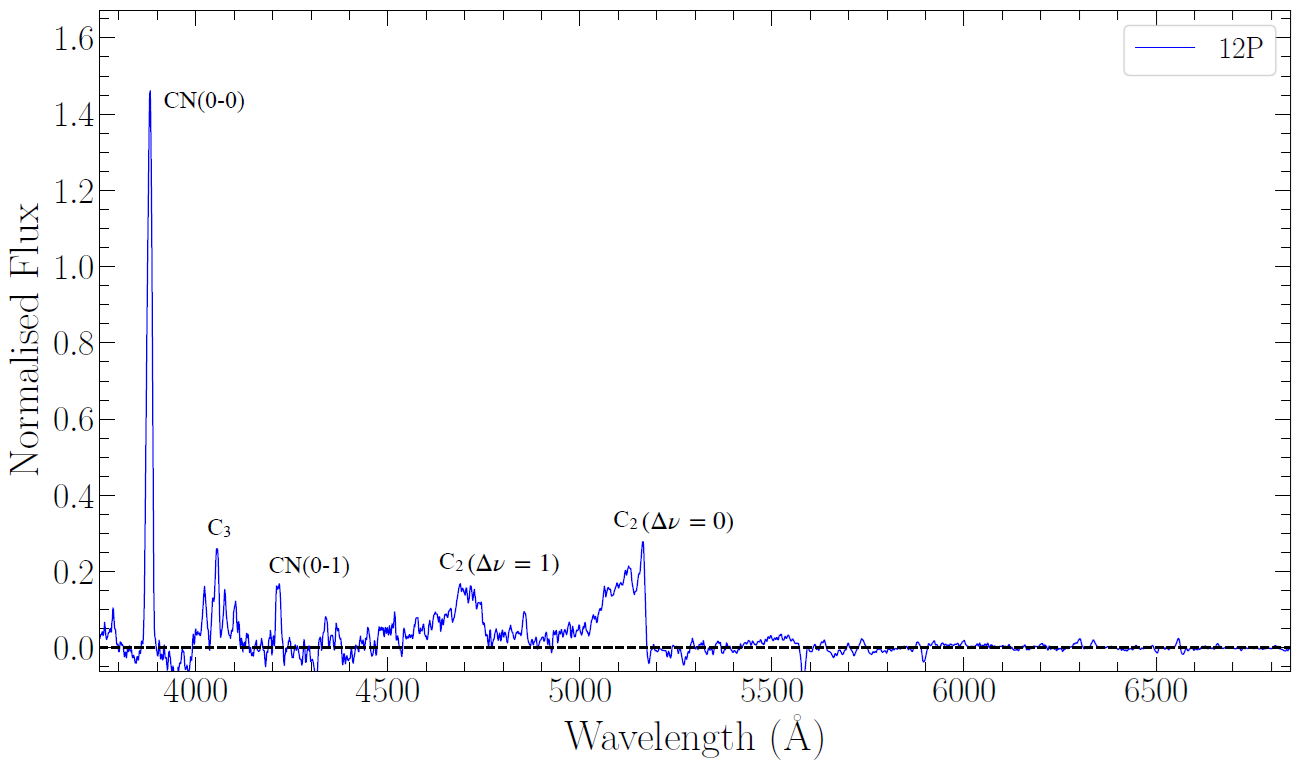
This comet will pass closest to the Sun on 21 April 2024, and will have its closest approach to Earth on 2 June 2024 (when it will pass at 1.5 times the distance between Earth and Sun). It is expected that this comet will be easily seen with small telescopes or binoculars, or even with the naked eye at that time. Comets always hold great fascination for all of us, and we will photograph this comet with our telescopes in the coming months to share its journey with everyone.
Comet C/2022 E3 (ZTF) at closest distance to the Earth
We have observed Comet E3 on February 02 and February 04, 2023, when it was at the closest distance to the Earth: at 0.2856 AU on Feb. 02, and at 0.3003 AU on Feb. 04. The comet has developed very large coma – actually larger the telescope’s FOV, and we estimate its magnitude to be about 4.6. This time we have observed the comet in a very special mode – when the telescope follows the comet as it moves fast through the sky; because at that time the comet’s physical speed was ~58 km/sec; and the angular speed was 1 pixel per second.
We have created an RGB – a true colour – image by co-adding the images in B, V and R. The famous green coma of this comet is the result of large amount of cyanogen (CN: a carbon-nitrogen bond) and diatomic carbon (C2: a carbon-carbon bond) molecules in the comet: solar UV light excite the electrons in these molecules, causing them to emit a green glow when they drop back down in energy. Coma’s green colour is also an indicator that the comet is active (outgassing) and warm (close to the Sun), and that the potential for an eruption from the comet's nucleus is at its highest.
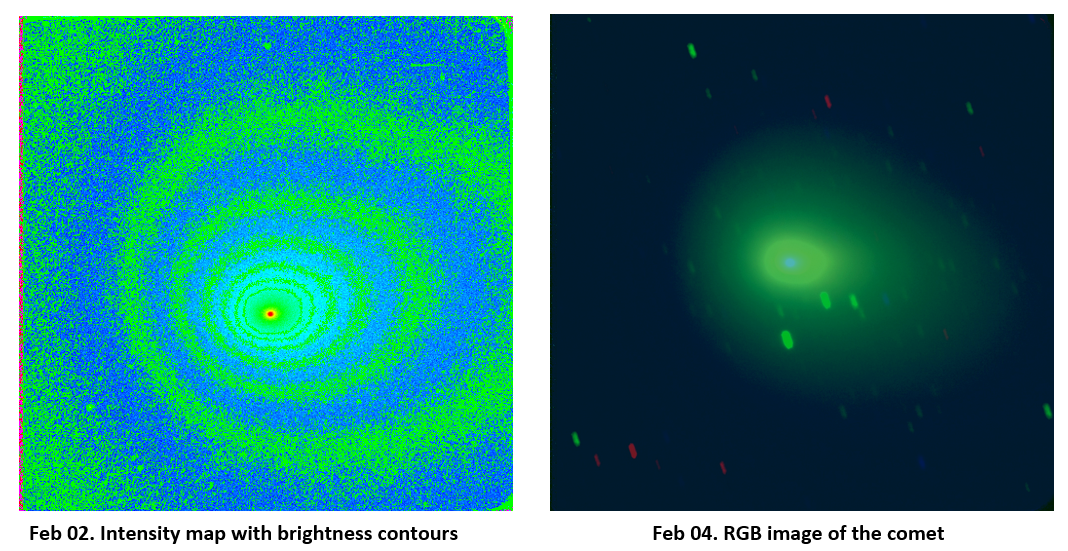
That is why we have processed the images using different enhancement techniques to reveal active structures in the coma, which are shown in the image:
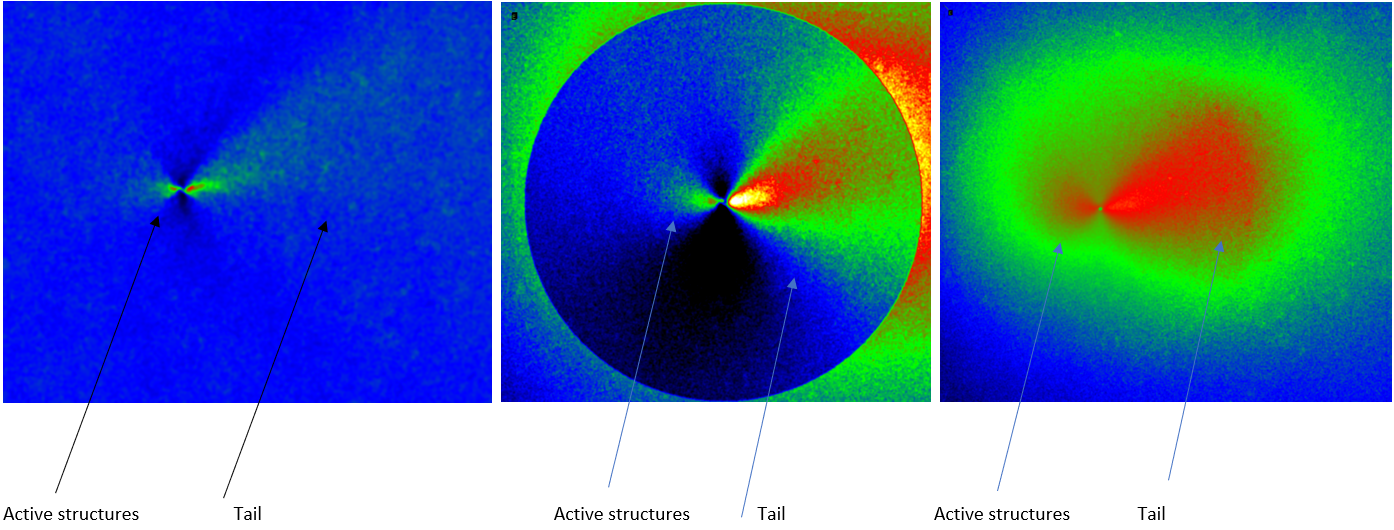
Intensity maps of comet C/202 E3 in R filter. Left: image processed by a rotational gradient method; Middle: image to which a division by 1/r profile was applied, and Right: image divided by the median. Very clearly we see the forward expulsion of the matter to the front of the coma, which faces the Sun.
Observers: Margarita Safonova and Mulchand Kurre (IIA). Images processing and manipulation: Margarita Safonova, Binukumar Nair (IIA) and Olexandra Ivanova (Astronomical Inst. Slovak Academy of Science, Slovakia).
Comet C/2020 V2 (ZTF)
Another comet visible in the northern skies this year was also discovered by the Zwicky Transient Facility (ZTF): Comet/2020 V2 (ZTF). It will pass the perihelion on 8th May at a distance of 2.23 AU, and its closest approach to Earth will be on September 17 at ~1.85 AU. But it is already quite bright with magnitude of about 12 (see further), though it won't brighten to a naked-eye visibility, but it will be visible for most of the year with the help of a binocular with a 80-mm aperture, or a small telescope.
It seems that this comet is not a periodic comet as the eccentricity of its orbit is estimated to be greater than 1: e=1.0012. With negative semi-major axis of about -2000 AU, it is a hyperbolic orbit comet, which means that it will pass through the Solar System only once. But it is still the Solar System comet, likely originating from the Oort cloud, as interstellar comets have eccentricities much greater than one, for ex., eccentricity of comet Borisov was 3.314.
We observed Comet/2020 V2 on Jan 2 with the HCT (IIA, Hanle) in 3 filters: B (2x240sec), V (2x200sec), and R (300 sec total of 6 exposures). We also created the RGB image – the `true’ colour image by co-adding the images in B, V and R bands. Comet C/2022 E3 has a wide coma and a short tadpole-shaped dust tail. We do not see the ion tail here. We also estimated its brightness as 12.7 in B, 12.3 in V, and 11.8 in R.

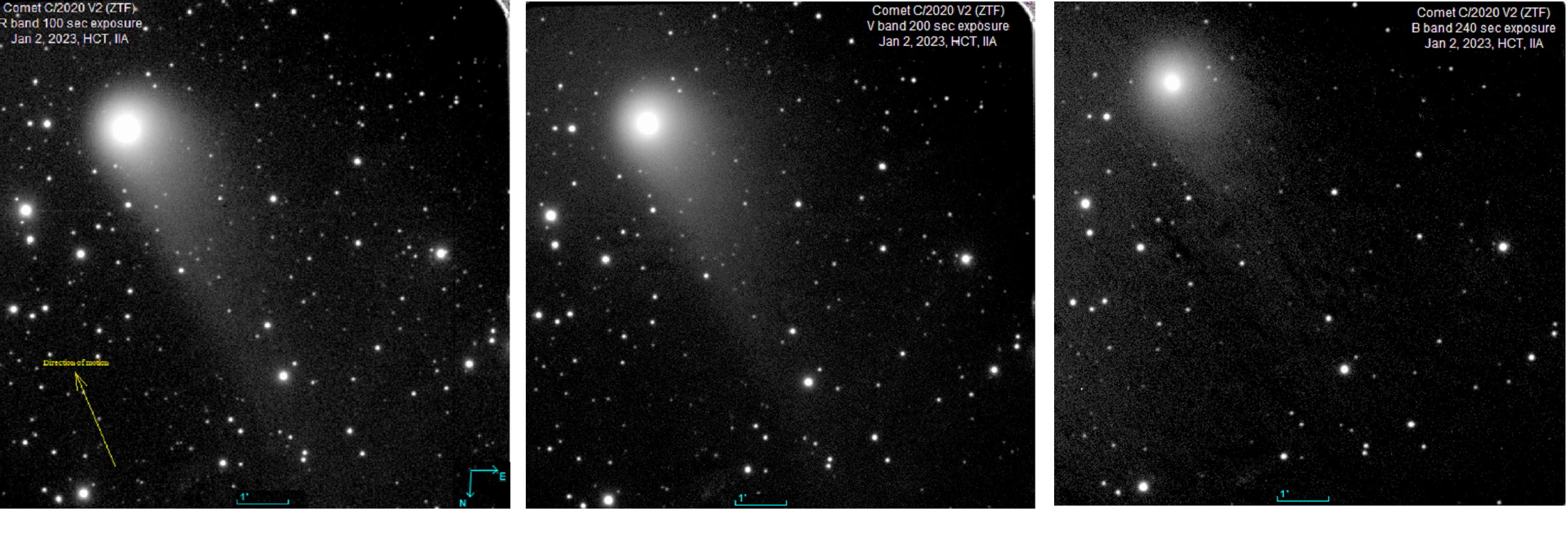
Observers: Margarita Safonova and Mulchand Kurre (IIA). Image manupulation: Margarita Safonova and Bharat Chandra (IIA). Brightness calculation: Igor Lukyanyk, Olexandra Ivanova (Astronomical Institute, Slovak Academy of Sciences).
Comet C/2022 E3 (ZTF)
C/2022 E3 (ZTF) is a long-period comet from the Oort Cloud that was discovered by the Zwicky Transient Facility (hence 'ZTF') on 2 March 2022 at Mount Palomar, California. Its estimated period is 50,000 years, so as jokingly written on different websites, Neanderthals were the last to see it. In December 2022 it was called the comet of the month as it expects to continue brightening and may be visible by the naked eye in Feb 2023 (upto 5th mag). It will pass the perihelion on Jan 12 at about 1 AU from the Sun, and will pass as close to the Earth as 0.3 AU in early February.
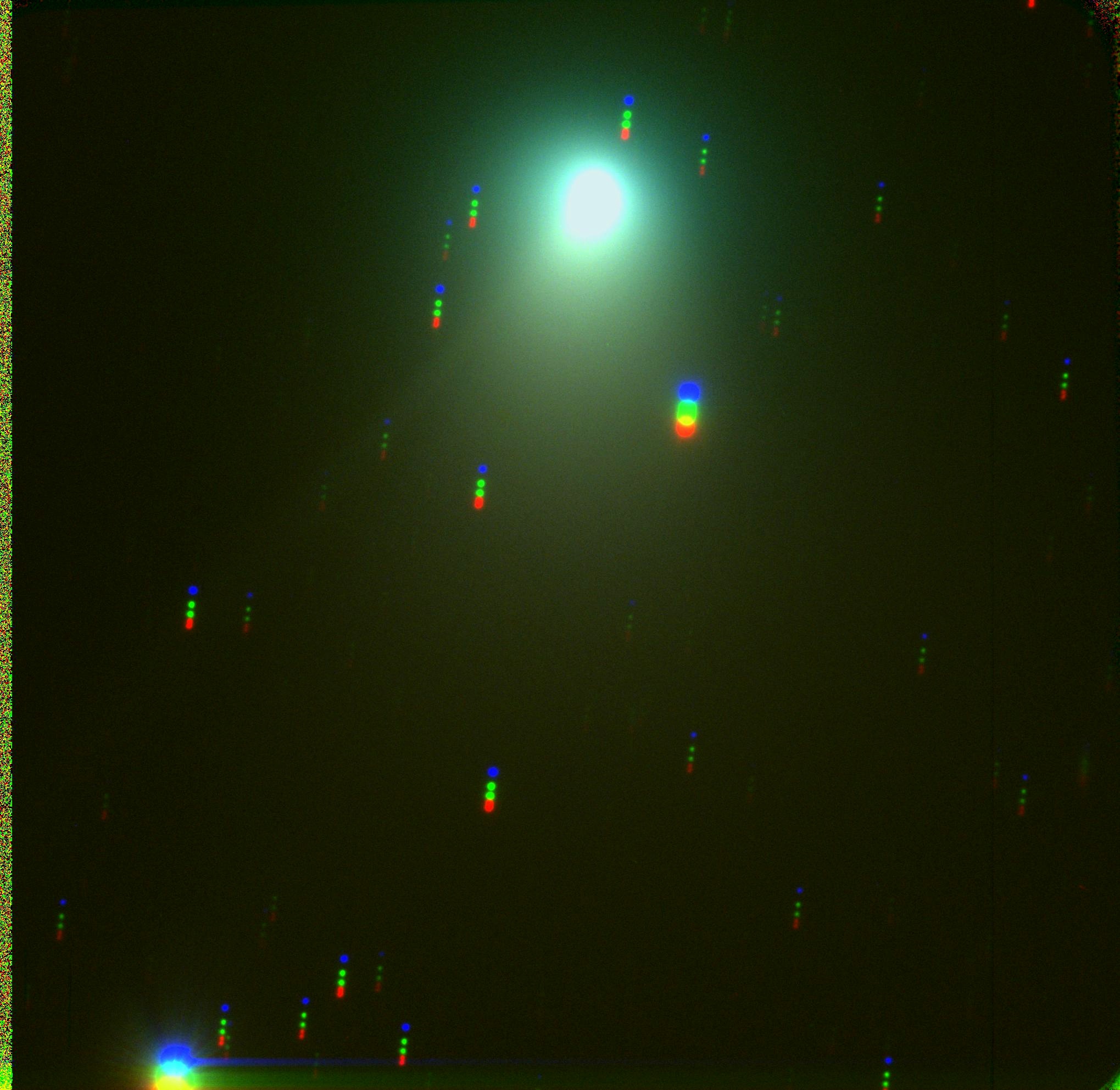

We observed it on Jan 2 with the HCT (IIA, Hanle) in 3 filters: B (3x60sec), V (2x30sec), and R (4x10sec) to create the RGB – the `true’ colour image by co-adding the images in B, V and R bands. Comet C/2022 E3 has a greenish wide coma (at least 6' wide), a short fan-shaped dust tail, and a long, straight ion tail (by some estimates it is 2 degrees long). We calculated the magnitudes of this comet as follows: 10.4 in R band, 10.2 in V band, and 10.8 in B.
Observers: Margarita Safonova and Mulchand Kurre (IIA). Image manipulation: Margarita Safonova and Bharat Chandra (IIA).
Brightness calculation: Igor Lukyanyk, Olexandra Ivanova (Astronomical Institute, Slovak Academy of Sciences).
Comet C/2021
Comet C/2021 A1, now known as Comet Leonard, was discovered in January 2021 by a researcher Greg Leonard. It has a hyperbolic orbit and its journey here from deep space is estimated to have taken about 35,000 years. It will pass near Earth around Dec. 14, when it may be visible with binoculars or possibly even without them. We observed it on Nov. 25 with the HCT (IIA, Hanle) and estimate its brightness as 8th magnitude.
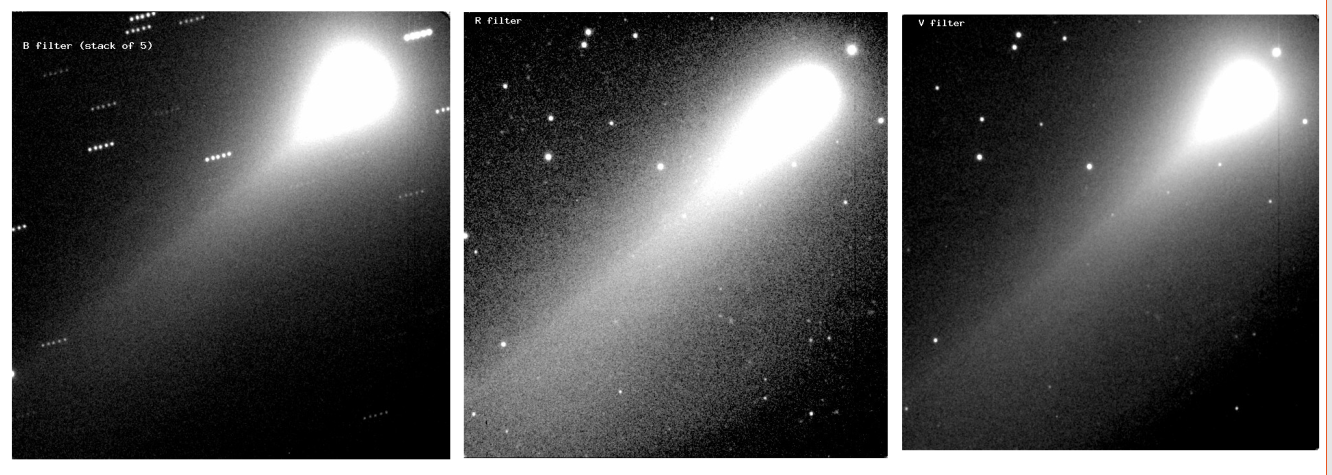
The comet demonstrates a very long tail – actually longer the HCT FOV (10’x10’). The cometary coma is asymmetric. Applying different enhancement techniques to the original images of the comet to make the faint structures visible, we have revealed two jet-like structures (marked by red arrows). These jets form the asymmetric cometary coma – in R filter (which reflects mostly dust) the coma is the usual oval shape, while B and V filters reveal mostly gas – that is why the coma shape is so different in these filters: the jets on both sides (marked by red arrows) create the triangular coma shape.
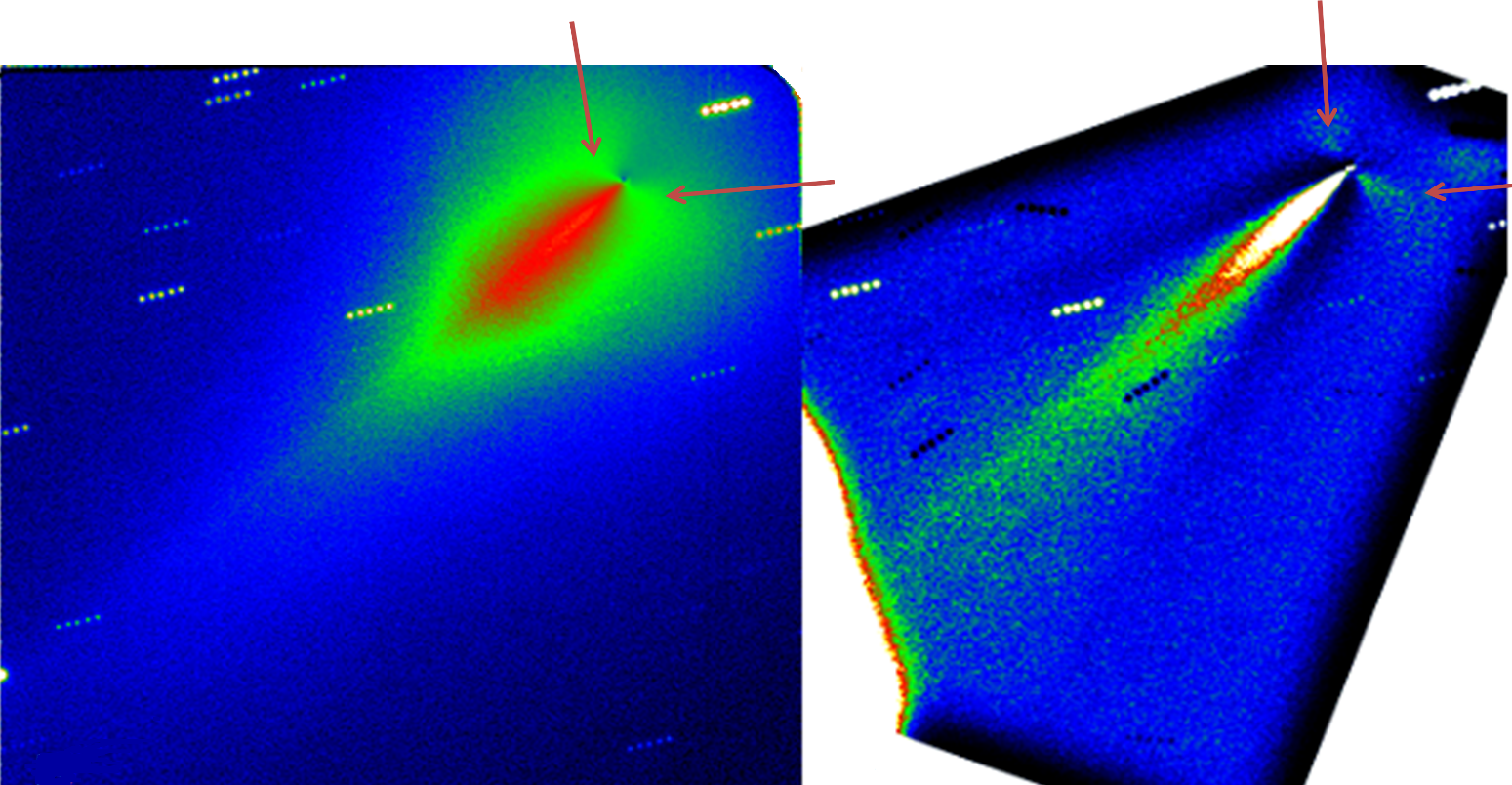
Intensity maps of comet C/2021 A1 Leonard in B filter. Left: image to which a division by 1/ profile was applied (Samarasinha & Larson 2014); Right: image processed by a rotational gradient method (Larson & Sekanina 1984).
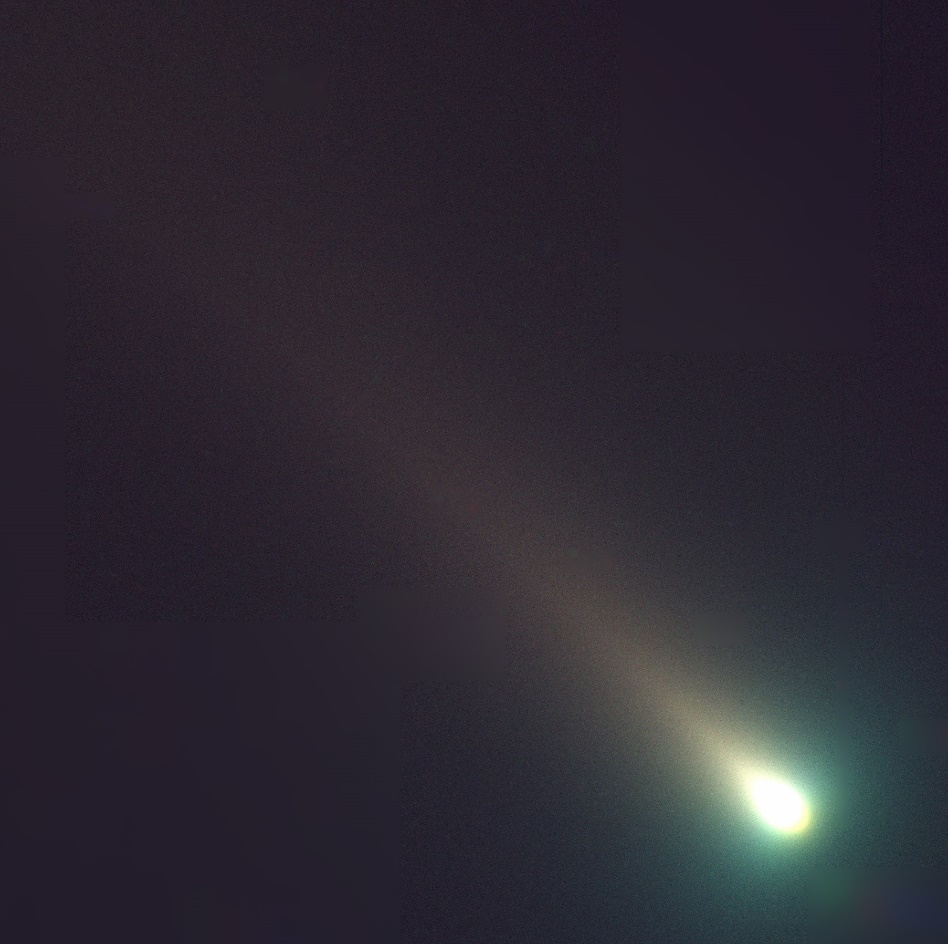
RGB: We have created an RGB – a true colour – image by co-adding the images in B, V and R. As the comet gets closer to the Sun, the nucleus of the comet gets hot, more of the ices melt and diffuse away from the surface, creating an extended, gas-rich cloud known as a coma. Sunlight striking the coma pushes the dust particles out of the coma and away from the Sun, creating a yellow/white tail: a dust tail. But coma has also gases created by sublimated ices like dry ice (solid CO2), methane (CH4), ammonia (NH3), and carbon monoxide (CO): these gases are mostly hydrogen, oxygen, carbon, and nitrogen. Two molecules that are of particular interest are cyanide/cyanogen (CN: a carbon-nitrogen bond) and diatomic carbon (C2: a carbon-carbon bond), and that is what gives the green colour to the coma: the Sun's UV light excite the electrons inside it, causing them to emit a green glow when they drop down in energy. Coma’s green colour is an indicator of a combination of things:
• that the coma contains large amounts of CN and C2 molecules,
• that the comet is active (outgassing) and warm (close to the Sun), and
• that the potential for an eruption or the comet's nucleus splitting apart is at its highest.
Observers: Margarita Safonova and Kiran B.S. (IIA). Image manipulation: Margarita Safonova, Bharat Chandra (IIA) and Olexandra Ivanova (Astronomical Inst. Slovak Academy of Science, Slovakia).
Comet C/2017K2 (PanSTARRS)
In the framework of our program of Oort cloud comets observations, we have observed this interesting comet, assumingly the brightest comet ever detected -- it was even called the “Comet of the Week” on June 6 last year. It was discovered in 2017 by the Pan-STARRS program at a distance beyond Saturn (16.1 au to the Sun) and it was already active with 130,000-km-wide coma (10 times Earth's diameter).
Some comparisons have already been made with the giant comet Hale-Bopp, which flew by in 1997 and is considered one of the brightest comets of modern times. However, it's still too early to tell if K2 truly is of a similar size or if it will shine as bright as Hale-Bopp. It is almost certainly a dynamically old Oort spike comet which has already visited our planetary zone during its previous perihelion passage millions of years ago. While the comet approaches its perihelion on December 20, 2022, it is the target of numerous studies because the long-term monitoring data is very valuable and helpful in studying the activity mechanism of comets at different heliocentric distances from the Sun. The comet should certainly reach naked-eye brightness, perhaps even 5th magnitude.
We have observed it on 10th September in 3 filters: B (3x300sec), V (4x240sec), and R (4x120sec) to create the RGB – the `true’ colour image. Our observations revealed extended 1.2’-wide coma and at least 5.5’-long tail. At its distance of ~5.412936 AU, the coma is ~282,660 km, and the tail is about 1 million 300 thousand-km long. Interestingly, last September the length of the tail was about 800,000 km.
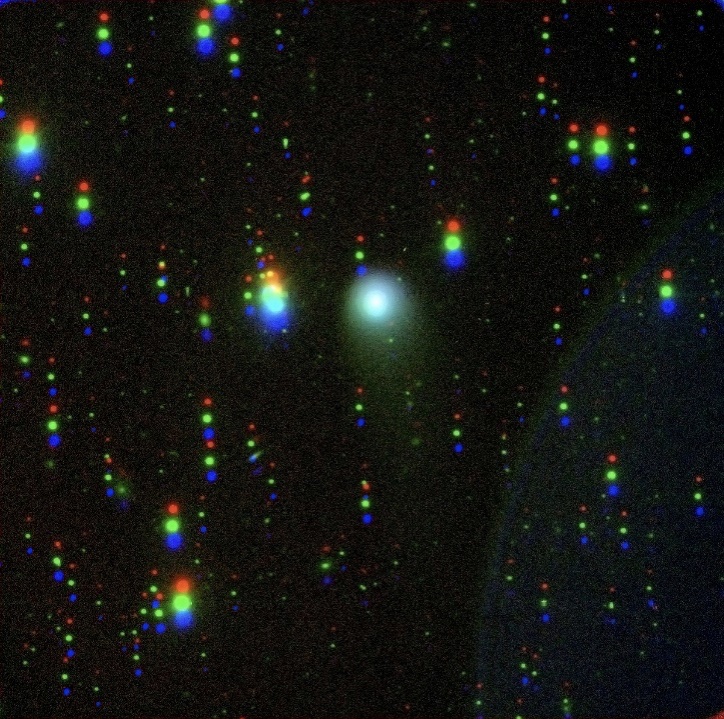
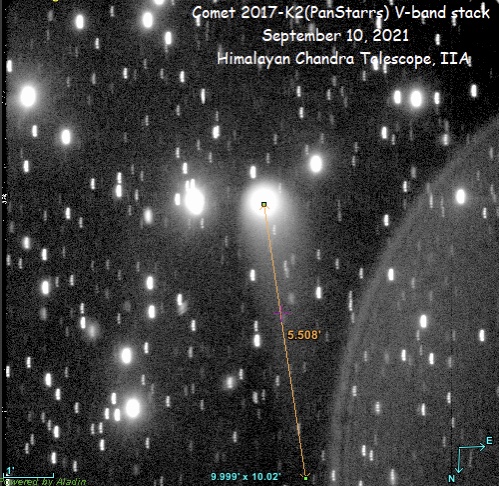
Observers: Margarita Safonova and Sujith D. S.
Image manipulations: Margarita Safonova, Igor Luk’yanyk and Bharat Chandra.
The light to the right of the comet is the spillover from the overbright 4th magnitude star epsilon Herculis.
Posted on: 29th Sep 21

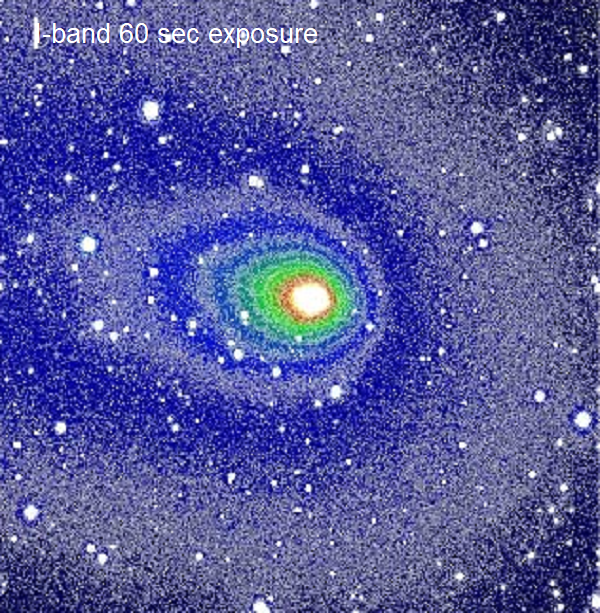
There is no dearth of spectacular comets in our skies this fall. One of them is the comet C/2020M3 (ATLAS), called so because it was discovered in 2020 (in June) by the Asteroid Terrestrial-Impact Last Alert System (ATLAS). It had passed the perihelion on 25 October, and was closest to the Earth at just 2.9 light-minutes away on November 14th. It turned out to be a periodic comet, but its next visit will be only in 2159. Surprisingly, this comet does not have a pronounced tail, but has an extended coma, about 340,000 km in diameter by some estimates: almost the distance from Earth to the Moon.
We have taken images of this comet on HCT, Hanle on November 17th in B, V, R and I filters (top row of images). It is much brighter in I filter which suggests that it has lots of dust in the coma (the 60-sec I image shows the extent), but only a spectroscopic analysis can reveal the actual details of the emission. Each image shown here is 10x10 arcmin in size.
Observers: Margarita Safonova and Pramod Kumar (IIA)
Image manipulations: Marek Husarik and Oleksandra Ivanova (Astronomical Institute of Slovak Akademy of Science, Slovakia).
Astronomical Event: Penumbral Lunar Eclipse
Event Time in Bangalore
Penumbral Eclipse begins - 10 Jan, 22:37:44 (10.37 pm)
Maximum Eclipse - 11 Jan, 00:40:02 (12.40 am)
Penumbral Eclipse ends - 11 Jan, 02:42:19 (02.42 am)
https://www.timeanddate.com/eclipse/lunar/2020-january-10
---------------------------------------------------------------------------------------------------------------------------------------------------------------------------------------
Comet C/2019 Q4 (Borisov)
The comet C/2019 Q4 (Borisov), or 2I/Borisov, was discovered just less than 2 months ago, and already gained enormous interest as it turned to be from outside the Solar System (SS). IAU Minor Planet Center wrote: ‘Based on the available observations, the orbit solution for this object has converged to the hyperbolic elements, which would indicate an interstellar origin.’ The other indications are its much higher velocity than usual SS comets, at more than 30 km/sec, and the orbit nearly at a right angle to the ecliptic. This is the first interstellar comet in our times, and the second interstellar object; the first was asteroid Oumuamua that passed through the SS in 2017.
The call for observations went out to everyone all over the world because the more observations are performed, the more precisely the orbit can be determined. We have observed the comet with the HCT on 13th and 14th September with the Himalayan Chandra telescope (HCT), Hanle (MPC code: N50) in 3 filters V, R and I. Each exposure was only 100 sec because it is moving so fast, thus we have combined the exposures in every filter to increase the signal. We show here images in three filters to show the difference in the comet appearance in different bands: in V the tail is longer and straight, while in R and I the tails are shorter and spread out. V image is a stack of 9 frames; R image is a stack of 7,and I image is a stack of 3 frames.
On 13th September, the comet was at 3.389 AU at the start of observations and at 3.388 AU at the end. On 14th it was already at 3.367 AU, covering angular distance of 0.53 deg in just one day. It is interesting to note that, according to other observers as well, the comet colours are the same as our SS comets colours indicating that chemistry is no much different in other solar systems.
Our observations (RA, Dec and UTC) are published in the Minor Planet Centre Electronic Circular (M.P.E.C. 2019-T169, issued 2019 October 9), and will be used for refining the orbital parameters.
Observers: Margarita Safonova and C.G. Anaswar.
Image manipulations: S. Akaash and Bharat Chandra.

Figure: RGB image of the comet Borisov
The RGB image is a combination of frames taken in V, R and I filters, each of ~300 sec combined exposure, and aligned on the comet's optocentre.
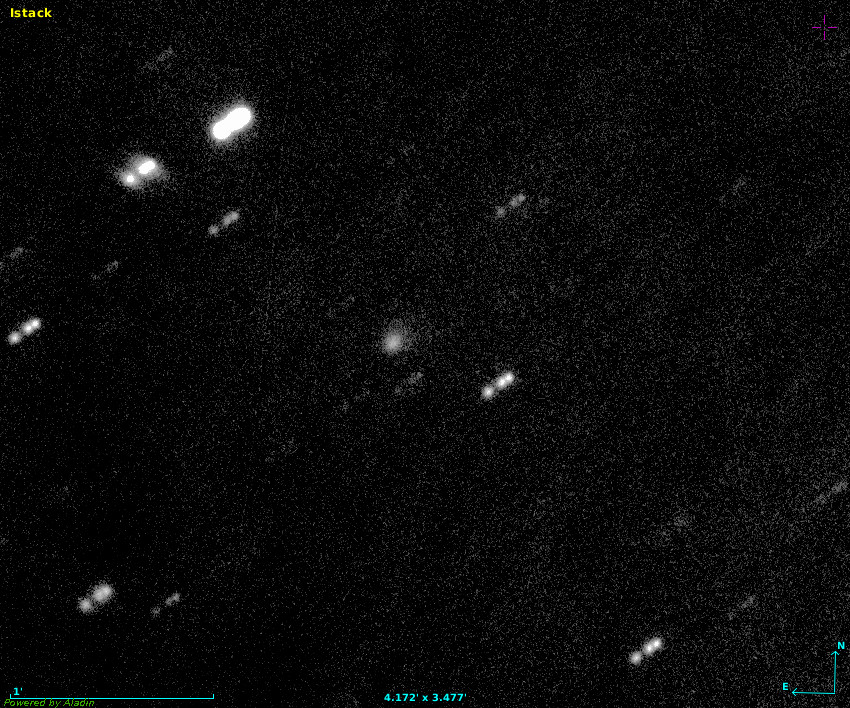
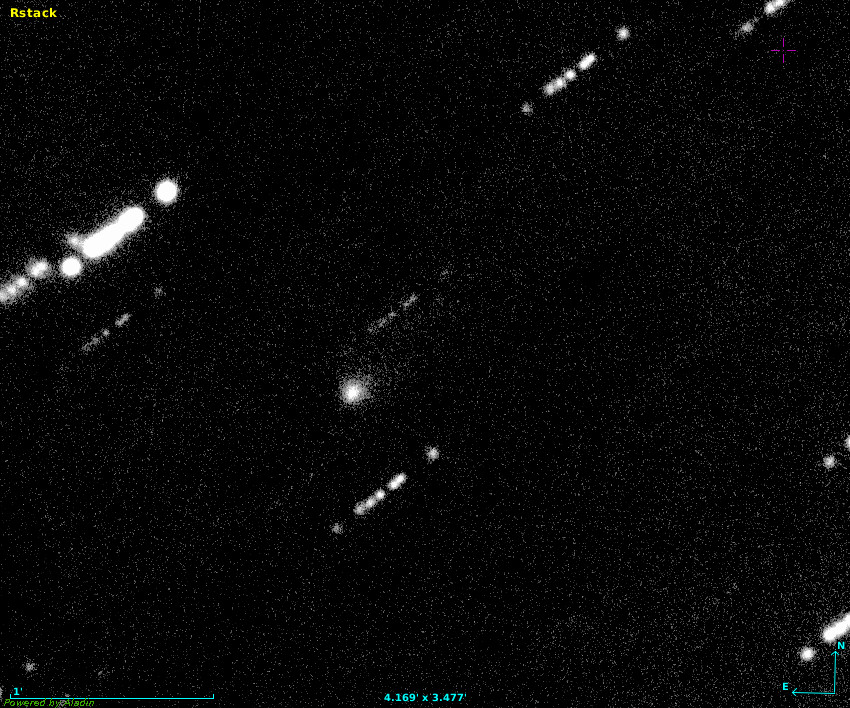
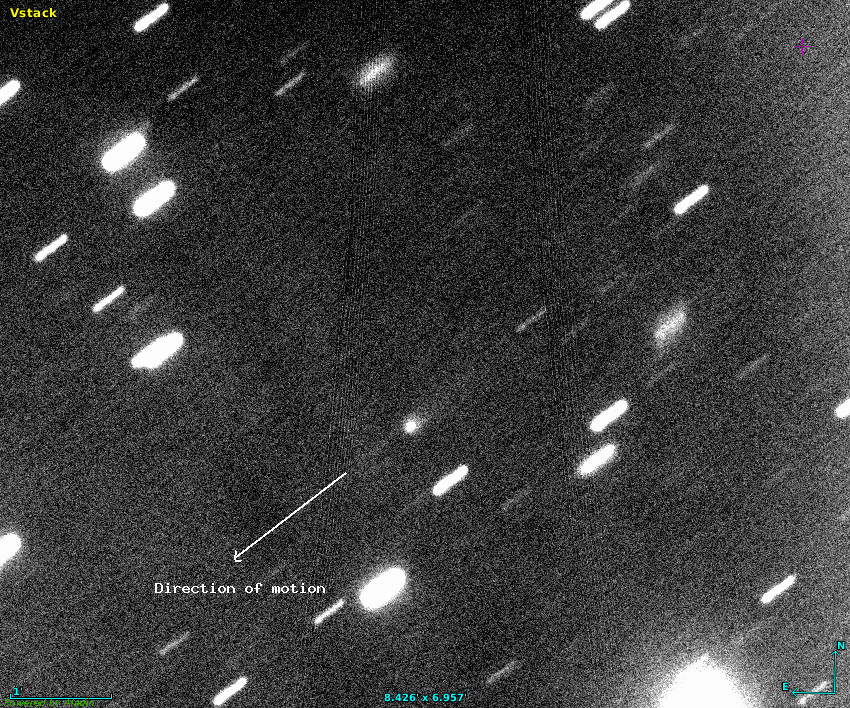
**********************************************************************************************************************
We conclude our observations of comet 46P/Wirtanen with December 2018 images taken on the 2-m HCT, Hanle,
and on the 1.3-m JCBT, Kavalur.
The comet has reached the perihelion on December 12, 2018. The movie of the comet motion was made from 51
R-band frames, each of 6 sec, taken on December 13, 2018.
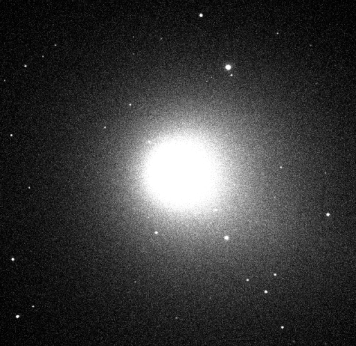
The RGB image is a combination of frames taken in R, V and B filters, each of ~180 sec exposure, and aligned on
the comet's optocentre. The comet frames were taken with the non-sidereal tracking of the comet.

HCT: Margarita Safonova, Kiran B. S. and Rakesh C. M.
JCBT: Ayaush Keshava and Venkatesh Shankar.
Image manipulations: Rekhesh Mohan (movie) and Bharat Chandra (RGB).
___________________________________________________________________________
This 600 sec R-band frame was taken in the Keystone mode of the HCT with non-sidereal tracking - where the comet stays in the centre and the stars trail. The saturated star in the image is the 8th V mag star Tyc 6431-211-1. The Keystone mode-compatible files have been generated by Firoza Sutaria using the ephemeris data for the comet from NASA JPL.
Observers: Margarita Safonova, Binukumar Nair and Kiran B.S.
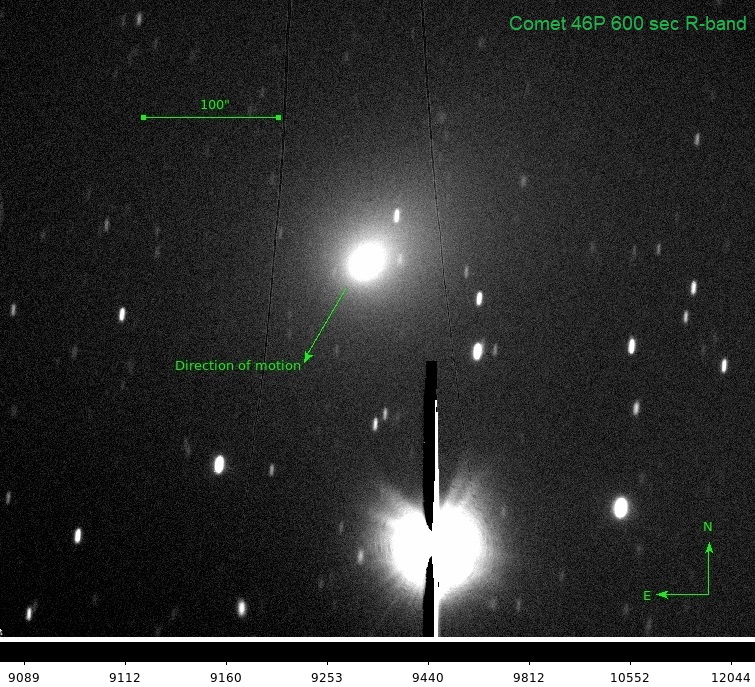
__________________________________________________________________________
The following images of the comet 21P/Giacobini-Zinner were taken on October 09, 2018 in three bands: R, V and B. The comet
is moving away from the Sun and is currently at a distance of 1.3 AU from the Sun, getting fainter.
Observers: Margarita Safonova, Binukumar Nair and Kiran B.S.
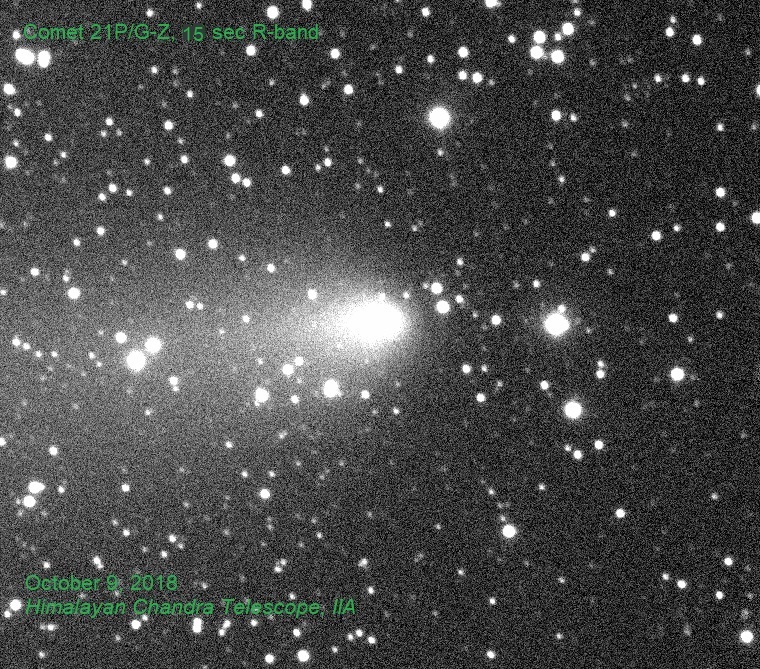 |
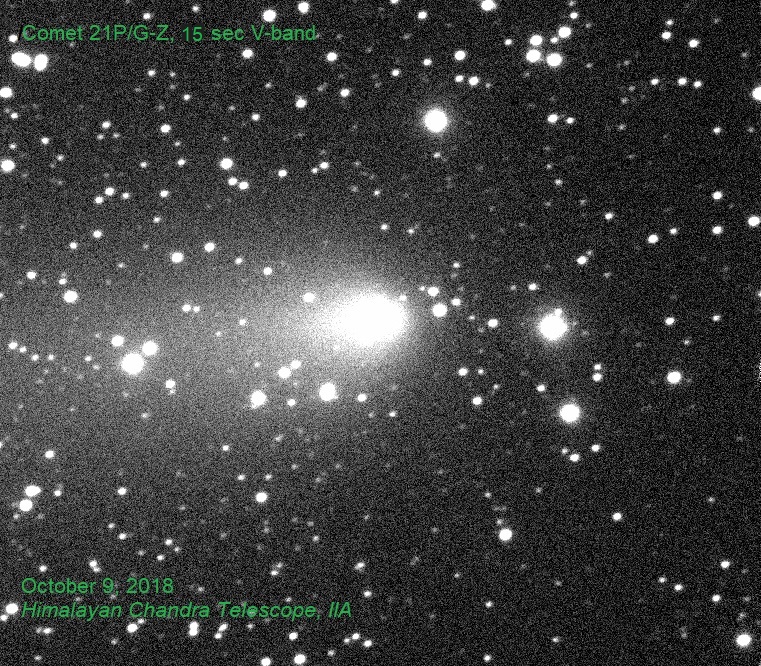 |
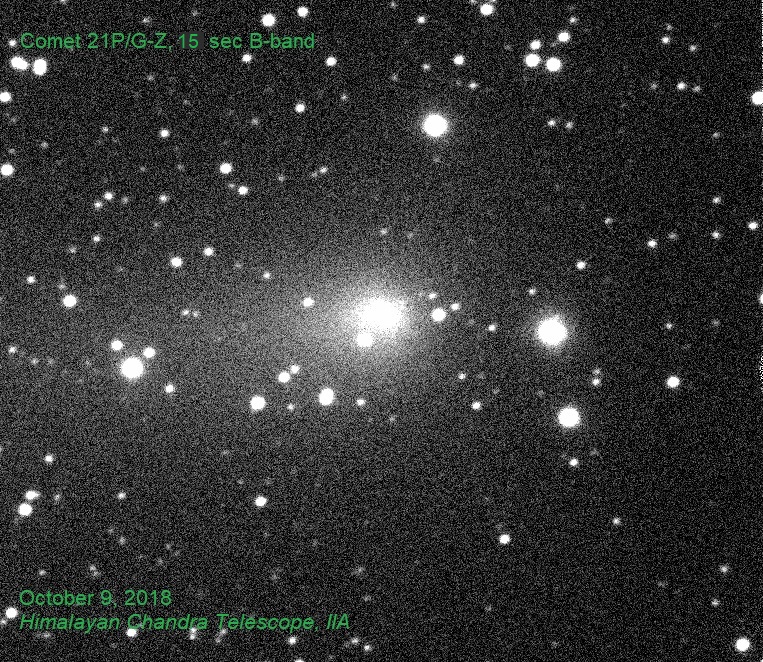 |
__________________________________________________________________________
The following images of comet 21P/Giacobini-Zinner and comet 46P/Wirtanen were taken in September 2018 on the HCT, IIA.
21P/G-Z is a periodic Jupiter family comet with period of ~6.54 years. It is the parent to the annual October Draconid meteor shower. The perihelion occurred this year on September 10th and was the closest for the last >70 years. This comet is called a green comet because some images show the comet's coma/tail as a green colour indicating the comet has cyanogen and diatomic carbon: gases that glow green in sunlight. This RGB image is a combination of frames taken in R, V and B Bessel filter, each of 20 sec exposure, and aligned on the comet's optocentre.
46P/Wirtanen is also a Jupiter family comet with period of about 5-6 years. It will reach perihelion on December 12, 2018, and perigee on December 16, and is expected to reach naked eye brightness: visual magnitude of 3.5 to 6. This passage of comet Wirtanen near the Earth will be the 10th closest approach of a comet in modern times. These two images are taken on 10th and 20th September 2018, with R-band 60 and 40 sec exposure, respectively.
These comets are observed as part of world-wide 4*P Coma Morphology Campaign (http://www.psi.edu/41P45P46P), organized by the Planetary Science Institute, looking for the features like jets, outflows as well as rotation of the nucleus, etc.
Observers: Margarita Safonova and Kiran B. S.
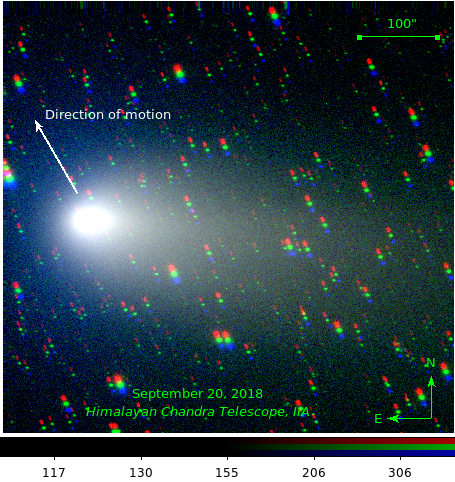
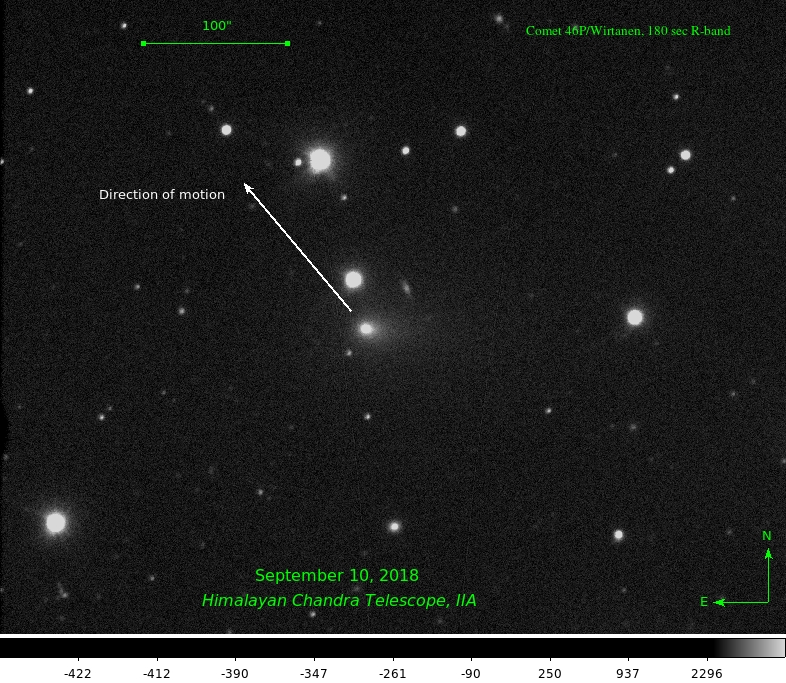
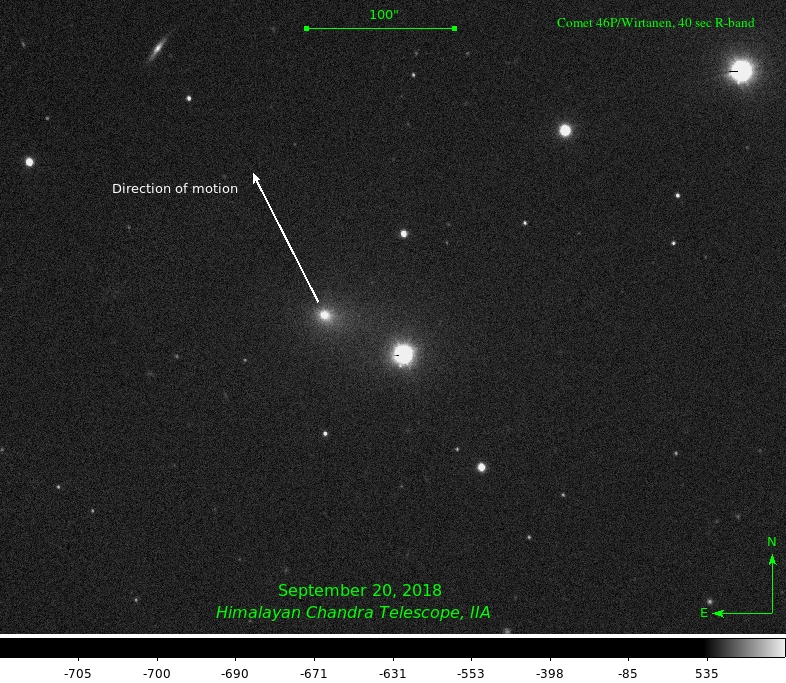
__________________________________________________________________________
Following images of comet 41P/Tuttle-Giacobini-Kresak were taken on 31st March 2017 with the Himalayan Chandra Telescope (HCT) at the Indian Astronomical Observatory (IAO) at Hanle, by Dr. Margarita Safonova and Mayuresh Sarpotdar, Indian Institute of Astrophysics, Bangalore.
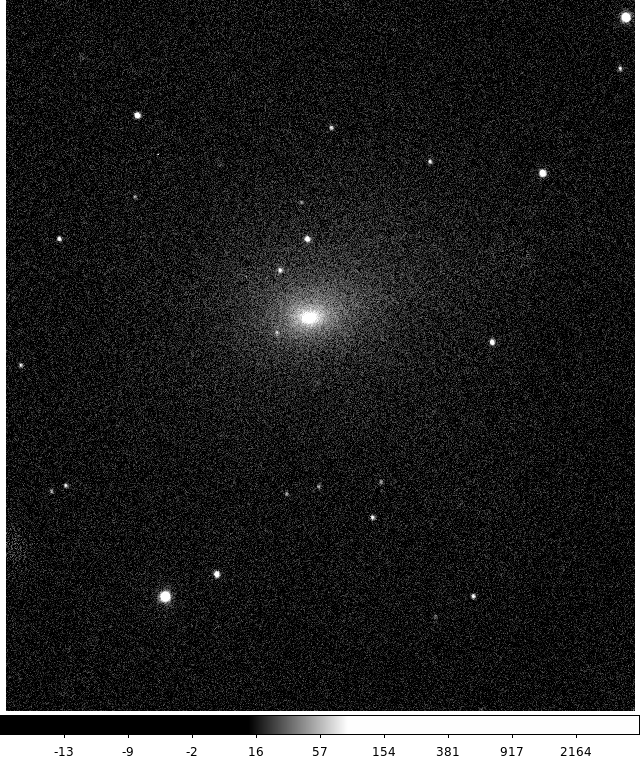
18:00:41.00UT, 5 sec, R band single exposure.
Observers: Margarita Safonova, Mayuresh Sarpotdar and Pramod Kumar

Comet movie made out of 10 5-sec R band exposures.
Observers: Margarita Safonova, Mayuresh Sarpotdar and Pramod Kumar
__________________________________________________________________________
- Useful links on Comet ISON
- Your Guide to Track ISON Comet: (BangaloreMirror article)
- Book on Comets
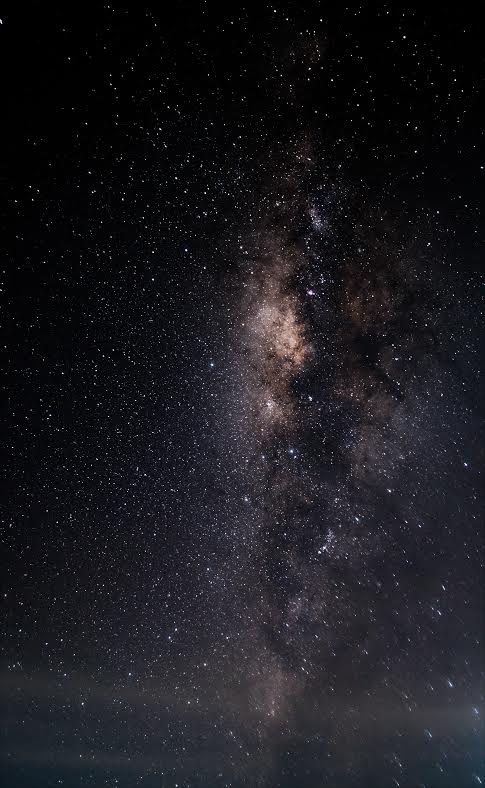
Milky Way Observed from Kodaikanal Solar Observatory, using DSLR Camera (D5200)
Observers & Photographers: Ramya Anche & Mayuresh Sarpotdar
ISO : 3200
F# : 3.2
Exposure : 13 sec
Stack of 50 frames of 13 seconds each. Total exposure : 10 mins 50 seconds.
__________________________________________________________________________
Nova Sagittarii 2015 No. 2 Observed from IIA Bangalore, using digital Cameras ( Canon SX 150 and Canon 1100D)
Observers were: Prasanna Deshmukh & Mayuresh Sarpotdar
__________________________________________________________________________
Comet Lovejoy Observed from IIA Bangalore, using digital Cameras ( Canon SX 150 )
Observers were: Prasanna Deshmukh, Joice Mathew, Mayuresh Sarpotdar
__________________________________________________________________________
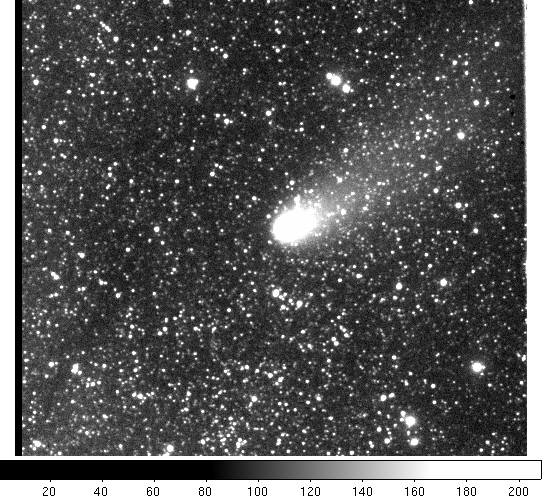
Comet images taken on 18th October 2014, Himalayan Chandra Telescope (HCT), as part of the world-wide campaign to monitor comet's encounter with Mars.
Observers were: Sreejith, Joice, Mayuresh, Pramod; Ephemeris calculations: Firoza Sutaria; Data Reduction: Margarita Safonova; PI: Jayant Murthy.
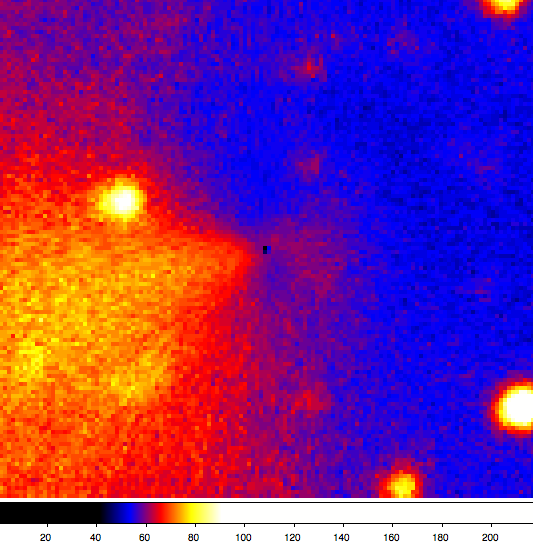
Above image was processed by image enhancement technique by Nalin Samarasinha (Planetary Science Institute, USA) to extract the underlying features.
__________________________________________________________________________
C/2012 S1, also known as Comet ISON, is a sungrazing comet discovered on 21 September 2012 by Vitali Nevski and Artyom Novichonok . The discovery was made using the 0.4-meter (16 in) reflector of the International Scientific Optical Network near Kislovodsk, Russia and the automated asteroid-discovery program CoLiTec. Precovery images by the Mount Lemmon Survey from 28 December 2011 and by Pan-STARRS from 28 January 2012 were quickly located. Follow-up observations were made on 22 September by a team from Remanzacco Observatory in Italy using the iTelescope network. The discovery was announced by the Minor Planet Center on 24 September. Observations by SWIFT suggest that C/2012 S1's nucleus is around 5 kilometers (3.1 mi) in diameter.
C/2012 S1 will come to perihelion (closest approach to the Sun) on 28 November 2013 at a distance of 0.012 AU (1,800,000 km) from the center point of the Sun. Its trajectory is nearly parabolic, which suggests that it may be a dynamically new comet coming freshly from the Oort cloud. On its closest approach, C/2012 S1 will pass about 0.0724 AU (10,830,000 km) from Mars on 1 October 2013, and it will pass about 0.429 AU (64,200,000 km) from Earth on 26 December 2013.
_____________________________________________________________________________________
Comet ISON Observed from IIA Bangalore, using digital Cameras ( Canon SX 150 )
Observers were: Prasanna Deshmukh, Ramya Manjunath, Mayuresh Sarpotdar
>>> Book on Comets
Mathematical Fun with Comets Problems with solutions - by Margarita Safonova and Shrihan Agarwal
_____________________________________________________________________________________________
